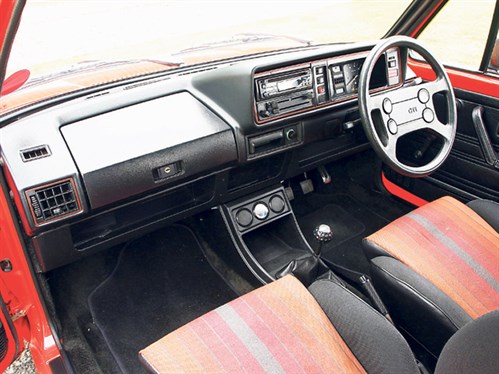
Introduced in 1974, the MK1's Golf combined sharp and refreshingly modern styling with peppy water-cooled engines. The range benefited from light weight and direct steering, combined with innovative suspension, resulting in masses of driving enjoyment regardless of the engine size. Buyers fell over themselves to get their hands on the newcomer, with over 2,000,000 Golfs finding homes in the first four years of production alone. In 1978 VW finally killed off Beetle production in Germany, safe in the knowledge that it had a winning replacement on its hands.
VITAL STATISTICS
Engine 1588cc/4-cyl/SOHC
Power (bhp@rpm) 110bhp@6100rpm
Torque (lb ft@rpm) 103lb ft@5000rpm
Top speed 110mph
0-60mph 9sec
Consumption 27mpg
Gearbox 5-speed manual
WHAT TO LOOK FOR
BODYWORK & CHASSIS
Mk1’s were never galvanised from new, so key areas to examine include the bottom of the A-pillar below the front windscreen and under windscreen rubbers. Rust here is bad news, as it’s usually structural and very difficult to repair to a decent standard. Sunroof cars need checking extra carefully, as rust there is tricky to fix.
Wheelarches are another problem area, particularly on GTI models – they are often hiding rust beneath their plastic arch spats.
If rear arches are rusty then check if the crustiness has spread underneath the car, as it could affect the suspension mountings – another nasty job to rectify. Front arches are part of the wings and an easier fix however. The fuel filler pipe can also rot, so if the pipe itself is rusty, then walk away. When rust finds it way into the tank and on through the fuel lines then real problems occur, particularly on GTis, as the sensitive Bosch K-Jetronic fuel injection system will be irrevocably damaged by any debris that finds it way inside.
ENGINE
Engines are generally tough, but most Mk1s will have done well over 100,000 miles now, so tired units are common. The engine block is rarely a problem, with the exception of the piston rings – any serious wear is most likely to be in the head itself. If there is a puff of smoke on start up, then the valve stem oil seals most
likely need replacing, smoke on the overrun is symptomatic of worn valve guides, while a plume of smoke under acceleration indicates worn piston rings. The camshaft belt needs replacing every 70,000 miles. Check the belt’s idler pulley at the same time, as worn idlers can seize.
Worn second gear synchromesh is a common weak point with gearboxes, revealing itself as a ‘crunch’ when changing up quickly from first to second, particularly when starting from cold. Sometimes first gear – plus fifth on five-speeders – can become difficult to engage. This is due to the alignment having shifted rather than the gearbox itself. A simple adjustment will often make a big difference. A sloppy gearshift can usually be revived with new bushes. Tired and worn engine mounts are common on these cars, so listen for any clunks when taking up drive.

RUNNING GEAR
Mk1's brakes are notoriously unimpressive, but replacing the original solid discs with grooved items will help improve matters. The automatic adjusters on rear drums are close to useless and are best attended to by turning the mechanism via a wheel stud hole. Front suspension is adjustable for camber, so if the tyres are unevenly worn, then something could be amiss there. Tired dampers are best replaced with gas items, while new front strut top mounts are best sourced from VW themselves.
NTERIOR
Upholstery and trim can be tricky to get hold of, so buy the best car you can in that regard. Many interior parts are no longer available from Volkswagen, so if you’re looking at a car that has issues interior-wise then you must factor this into your thinking.

OUR VERDICT
If you’re after a stylish, sharp-suited little runabout to potentially use all year round, then look no further. Whatever model you go for, it will be more than capable of taking on daily driver duties and general domestic errands, but still provide lashings of fun when the working day is done – particularly the ubiquitous GTI models. The trick is getting hold of one that hasn’t rusted away completely.